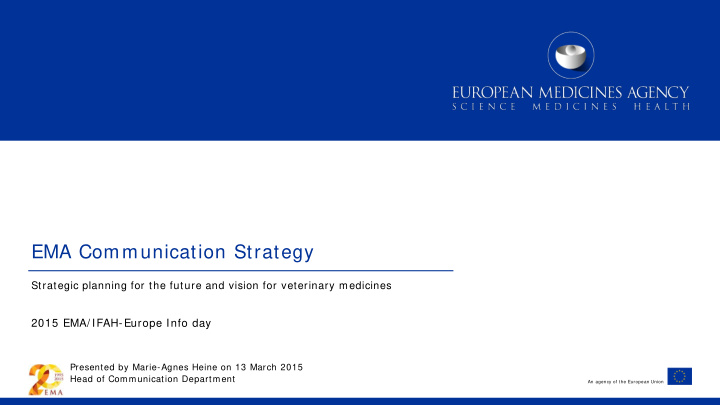



EMA Communication Strategy Strategic planning for the future and vision for veterinary medicines 2015 EMA/ IFAH-Europe Info day Presented by Marie-Agnes Heine on 13 March 2015 Head of Communication Department An agency of the European Union
1. Focus of presentation • Overview of communications approach • First steps • Draft Communications Plan for 2015 • Focus on veterinary communications 1 EMA Communication Strategy
2. Context • Development and regulation of medicines no longer field only for experts • Increasing demand for transparency and for information, knowledge and data around medicines • Stakeholders expect that information is prepared and distributed tailored for their needs • Cooperation with the Network (EC and MSs) requires more targeted information and channels • Increasing importance of internet, mobile communication and social media 2 EMA Communication Strategy
3. Our goals? Provide high quality inform ation on m edicines Facilitate w ork w ith partners and stakeholders Safeguard reputation of EU System and EMA Support achievem ent of Agency priorities 3 EMA Communication Strategy
4. What do we need? Understanding of stakeholders' needs and expectations I ntegration of communications Well-functioning into the overall w ebsite and use business of m ore planning cycle com m unication channels New corporate com m unication strategy aligned with corporate priorities 4 EMA Communication Strategy
5. First steps • Restructuring of Communication department • Establishment of focal points for better planning • Perception survey under preparation • Tender for communication services 5 EMA Communication Strategy
6. Objectives Provide high-quality inform ation on m edicines Enhance communication with EU Netw ork and other partners Promote better understanding of m edicines regulation in EU Analyse stakeholders' needs and expectations I m prove com m unication products and channels and the use of new tools Improve and broaden relationship w ith key m edia 6 EMA Communication Strategy
7. Key messages • EMA protects and improves public and animal health. • EMA cooperates closely with the network to ensure consistent communication. • EMA provides partners and stakeholders with independent, science-based information on medicines. • EMA has a 20-year track record of ensuring efficacy and safety of medicines for humans and animals across Europe. • EMA promotes innovation in medical and veterinary science. 7 EMA Communication Strategy
8. Key stakeholders • Partners (European Commission, NCAs, European Parliament, other EU Agencies, international bodies) • Stakeholders (patients, animal owners/ keepers, farmers, healthcare professionals, academia, HTAs, industry associations, SMEs and other pharmaceutical companies) • Media W hat about the general public? • Secondary audience for EMA • Receive info from their respective NCAs • Languages as a barrier for outreach 8 EMA Communication Strategy
8. Stakeholders (cont.) • The Agency disseminates key communications for example concept papers and draft guidelines open for consultation to stakeholders • Internal database • Over 330 organisations with validated contacts and identified areas of interest • 40 have identified veterinary medicines as an area of interest 9 EMA Communication Strategy
9. Activities 2015 • 20th Anniversary: • Use of logo in communications/ presentations throughout the year • Publication of anniversary book • Scientific conference • Series of internal events (special calendar to be published on the web) • Perception survey to identify gaps and challenges in stakeholder communications • Follow-up on online programme (upgraded corporate website, new extranet and intranet, EMWP) • Development of special communication plans around important events 10 EMA Communication Strategy
10. Communication on vet medicines • EPARs for all new veterinary medicines • EPMARs for all MRL assessments • Monthly reports on veterinary medicines • Press releases after CVMP meetings • Active dissemination of draft guidelines • News items on topical subjects 11 EMA Communication Strategy
11. Other examples of veterinary communication • Antimicrobial resistance ECDC/ EFSA/ EMA first joint report on the integrated analysis of the consum ption of antim icrobial agents and occurrence of antim icrobial resistance in bacteria from hum ans and food-producing anim als published January 2015 • Residues of phenylbutazone in horse meat Collaboration between EMA and EFSA Coordination within the EU network of both human and veterinary authorities Press release April 2013: Joint EMA/ EFSA assessment concluded illegal presence of phenylbutazone residues of low concern to consumers 12 EMA Communication Strategy
12. How we communicate? EMA website • 2 2 0 0 0 0 unique visitors per month • 5 8 5 0 0 0 visits per month • 1 5 0 0 0 0 total number of documents published on the website • 6 5 0 new documents published every month • 1 9 RSS feeds – Top: News and press release (over 10 000 subscribers) 13 EMA Communication Strategy
12. How we communicate? Working with the media in 2014 2 5 7 news releases published 4 5 4 phone calls with journalists 1 ,6 9 8 e-mail responses to media queries 3 3 interviews organised with EMA staff, including 4 TV interviews 1 press conference (by phone) 2 ,5 0 0 journalists on our media distribution list 14 EMA Communication Strategy
12. How we communicate? Use of social media W hat w e tw eet • News releases Other channels • Agendas & minutes of scientific committees • New guidelines • Public consultations • New European public assessment reports • Events and meetings open to the public • Job advertisements 15 EMA Communication Strategy
16 EMA Communication Strategy
13. What comes next? Carrying out 20 th anniversary programme • • Finalise and implement Communications Plan 2015 • Finalising press manual • Media training • Training on basic communication skills 17 EMA Communication Strategy
Thank you for your attention
Recommend
More recommend